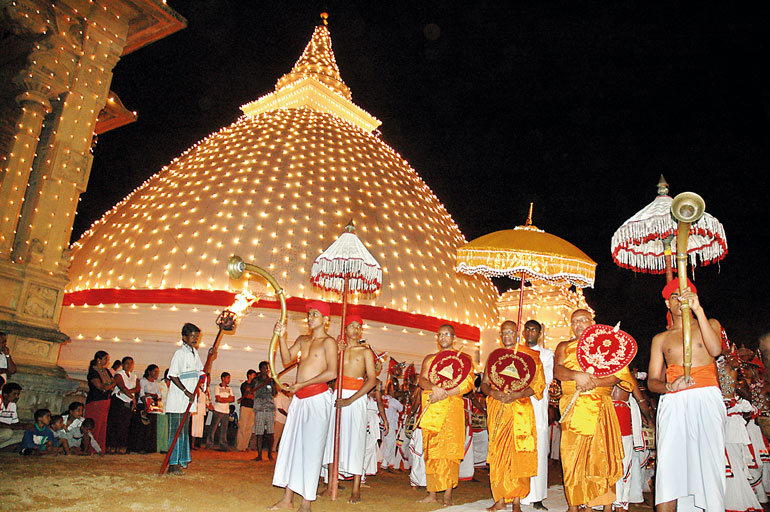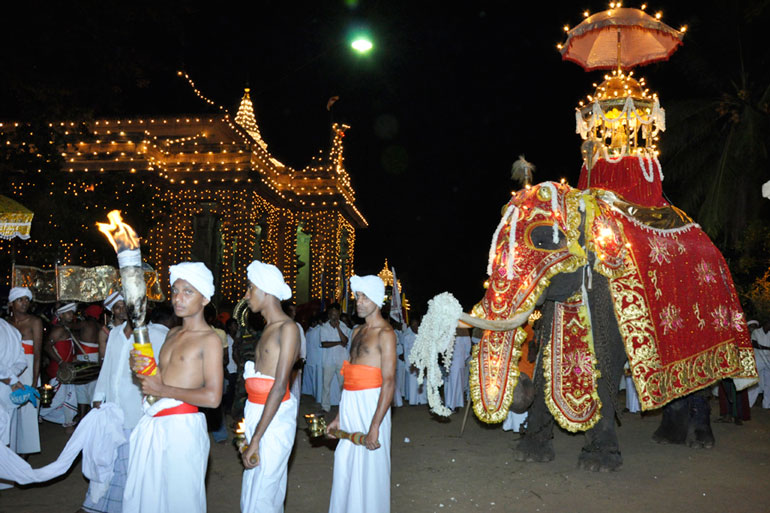Saturday Apr 19, 2025
Saturday Apr 19, 2025
Saturday, 23 January 2016 00:00 - - {{hitsCtrl.values.hits}}

By D.C. Ranatunga
An event related to the historic Kelaniya Raja Maha Vihara for 89 years takes place next week. It is the Duruthu Perahera held every year in the month of Duruthu – January. This year it took place on three days from Wednesday 20 January. This is also the first Buddhist religious/cultural festival in 2016.
The Perahera dates back to 1927 when it was held for the first time on the initiative of Don Walter (D.W.) Wijewardene after the completion of the restoration work. He was the son of the great philanthropist lady Henena Wijewardene, who restored the Kelaniya temple to its pristine glory in the early years of the 20th Century.
Kelaniya ranks as the third place visited by the Buddha. The Mahavamsa, the Great Chronicle, records the event thus: In the eighth year after he had attained to buddhahood, when the Vanquisher was dwelling in Jetavana, the Master, set forth surrounded by five hundred bhikkhus, on the second day of the beautiful month of Vesäkha, at the full moon, and when the hour of the meal was announced the Vanquisher, prince of the wise, forthwith putting on his robe and taking his alms-bowl went to the Kalyani country, the habitation of Maniakkhika. Under a canopy decked with gems, raised upon the spot where (afterwards) the Kalyanicetiya was built, he took his place, together with the brotherhood of bhikkhus, upon a precious throne-seat. And, greatly rejoicing, the naga-king with his following served celestial food, both hard and soft, to the king of truth, the Conqueror, with his followers.
When the Teacher, compassionate to the whole world, had preached the doctrine there, he rose, the Master, and left the traces of his footsteps plain to sight on Sumanakuta And after he had spent the day as it pleased him at the foot of this mountain, with the brotherhood, be set forth for Dighavapi. And there the Master seated himself with the brotherhood at the place where the cetiya (thereafter) stood, and gave himself up to meditation, to consecrate the spot. Then arose the Great Sage from that place, and knowing well which places were fit and which unfit he went to the place of the (later) Mahameghavanarama. After he had seated himself with his disciples at the place, where the sacred Bodhi-tree came afterwards to be, the Master gave himself up to meditation; and likewise there where the Great Thüpa stood (in later days) and there also where (afterwards) the thupa in the Thuparama stood. Then when he rose up from meditation he went to the place of the (later) Silacetiya, and after the Leader of the assembly (of bhikkhus) had uttered exhortation to the assembly of devas, he, the Enlightened, who has trodden all the paths of enlightenment, returned thence to Jetavana.

Thus the Master of boundless wisdom, looking to the salvation of Lanka in time to come, and knowing in that time the highest good for the hosts of asuras and nagas and so forth in Lanka visited this fair island three times, be, the compassionate Enlightener of the world; therefore this isle, radiant with the light of truth, came to high honour among faithful believers.
Here ends the visit to Kalyani.
The Buddha was fulfilling a request made by the Naga king Manakkhika mentioned above, when he met the Buddha on the latter’s second visit to Sri Lanka at Nagadipa. It was during the visit to Kelaniya that the Buddha visited over 10 other places in Sri Lanka as detailed in the Mahavamsa.
To commemorate the Buddha’s visit, the Naga king had built the dagoba in the shape of a heap of paddy. This is the dagoba venerated by the Buddhists to this day. While another had existed on the bank of the Kelani Ganga which flows alongside the temple, on the spot where the Buddha is believed to have kept his robes and taken a dip at the river, it had been destroyed by the Portuguese who had flattened the whole area during their rule in the 16th century.
Time of Sinhala monarchs
During the Anuradhapura period, Kelaniya seems to have been a sub-kingdom ruled by King Devanampiyatissa’s brother Uttiya who had reconstructed the dagoba and the monastery. Kelani Tissa, Uttiya’s grandson succeeded him. The Mahavamsa refers to how Kelani Tissa sent his daughter Viharadevi adrift in a boat to appease the gods of the sea and prevent his kingdom being swallowed up by the waves as retribution for killing of an ‘arahant’. The princess was cast ashore close to Mahagama (Tissamaharama) and King Kakavanna, being informed of her arrival, espoused her as her consort. She was the mother of Gamini, who unified the nation and ruled from Anuradhapura as Dutugemunu (161-137 BC).
During the Polonnaruwa era, Kelaniya has been referred to in the Pritidana inscription as one of the shrines visited by King Nissankamalla (1187-96 AC) in his tour of the religious places. He is said to have carried out extensive innovations at the temple and had also donated large extents of land for the upkeep of the temple and the monks.
With the invasion by the Kalinga ruler, Magha in 1215 AC, all temples including Kelaniya were left to rack and ruin. In 1232 Vijayabahu III (1232-36) gathered forces, defeated Magha and set up his kingdom in Dambadeniya. He repaired the image house and the dagoba at the Kelaniya temple. Huis son (Panditha) Parakramabahu II (1236-70) had restored the five-storied building that had been broken down and gifted a large coconut land for the temple to get coconut oil for ‘pahanpooja’.
Golden era
The golden era of the Kelaniya temple began with the shifting of the capital to Kotte in 1411 AC. Being in close proximity to the capital, the temple won due recognition with the king extending his patronage. The chief prelate, Vilagamulla Sri Parakrama Sangharaja (1411-66) saw to it that the temple rose to fame as a celebrated seat of learning. King Parakrama Bahu VI effected extensive renovations, added new edifices and developed the Kelaniya city too. The beauty and the splendour of the city with its temple inspired many a writer of prose and poetry during the period. In the celebrated ‘sandesa’ poem, Selalihini Sandesaya, Totagamuwe Sri Rahula Thera gets the bird to pass through Kelaniya. The poem gives an authentic disruption of the temple as it existed then.
During the reign of King Buvanekabahu VI (1469-77), King Ramadipathi of Burma (now Myanmar) sought the assistance of the king to reinstitute the Theravada ordination in his country, which had become extinct. The king sent 45 monks to Sri Lanka to receive higher ordination at the Kelaniya temple. The ‘upasampada’ ceremony was conducted by Vidagama Maha Thera in the Kelani Ganga on a set of boats hitched together covered with a canopy. Playing a leading role the king made valuable offerings to the Burmese monks each was given a new name of Sinhala origin.
The reign of King Dharma Parakramabahu IX (1489-1513) is rated as one of the most memorable periods in the history of Kelaniya temple. In the 19th year of his reign, he carried out extensive restoration work at the temple and set up an inscription on a large slab of granite. This inscription can be seen at the temple premises though broken into pieces by the Portuguese in late 16th century.
The king was so fascinated with the beauty of the place that he built a five- storied palace, on the further bank of the river in clear view of the temple. The kings of Kotte in latter years used this as their summer residence.
Devastation by Portuguese
In 1575, the Portuguese captain Diego de Mello after defeating a battalion of Sinhalese troops at Wattala proceeded to eelaniya and ordered the troops to destroy the temple. After looting the temple the troops demolished the buildings and razed the temple to the ground.
The Dutch who arrived in 1640 wanted to suppress Buddhism and propagate the Christina faith, a decree was issued prohibiting even the worship of the place where the Kelaniya chaitya stood. When Vimala Dharma Suriya II, King of Kandy tried to rebuild the temple in 1685, the Christian clergy objected and the Dutch refused permission. Two more requests were refused until in 1770 King Kirti Sri Rajasinha (1747-82) was granted his request in a move to please the king.
Ven. Dehigaspe Attadassi, a pupil of Vevivita Sri Saranakara Sangharaja, took residence at Kelaniya and carried our restoration work. Soon the dagoba, the image house, the devalaya and the monastery were rebuilt. Ven. Attadassi was given the incumbency of the temple by the king. He in turn later handed over the temple to his pupil Ven. Mapitigama Buddharakkhita, thereby establishing a line of succession.
The British era saw a rather indifferent attitude towards religion and with the Kandyan kingdom being taken over in 1815, there was no State patronage. This resulted in most temples being neglected and going into decay. The Kelaniya temple faced the same fate until Helena Wijewardene stepped in and resurrected the place. The rest is recent history.